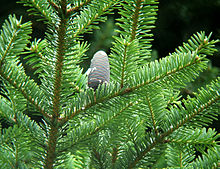Abies homolepis
| Nikko fir | |
|---|---|

| |
| Foliage and cone | |
| Scientific classification | |
| Kingdom: | Plantae |
| Clade: | Tracheophytes |
| Clade: | Gymnospermae |
| Division: | Pinophyta |
| Class: | Pinopsida |
| Order: | Pinales |
| Family: | Pinaceae |
| Genus: | Abies |
| Species: | A. homolepis
|
| Binomial name | |
| Abies homolepis | |
Abies homolepis, the Nikko firtemperate rain forest with high rainfall and cool, humid summers, and heavy winter snowfall.
It is a medium-sized to large
stomata below, and rounded or slightly notched at the tip. The leaf arrangement is spiral on the shoot, but with each leaf variably twisted at the base so they lie partially flattened to either side of and above the shoot, with few below the shoot. The shoots are yellow-buff, glabrous, and often conspicuously grooved. The cones are 6–12 cm long and 3–4 cm broad, purple-blue before maturity; the scale bracts are short, and hidden in the closed cone. The winged seeds are released when the cones disintegrate at maturity about 6–7 months after pollination.[citation needed
]
Uses
Nikko fir
]It is also a popular forest tree since it is resistant to air pollution.[3]
References
- . Retrieved 12 November 2021.
- ^ BSBI List 2007 (xls). Botanical Society of Britain and Ireland. Archived from the original (xls) on 2015-06-26. Retrieved 2014-10-17.
- ISBN 3-444-70130-6.
- Liu, T. S. (1971). A Monograph of the genus Abies. National Taiwan University.

